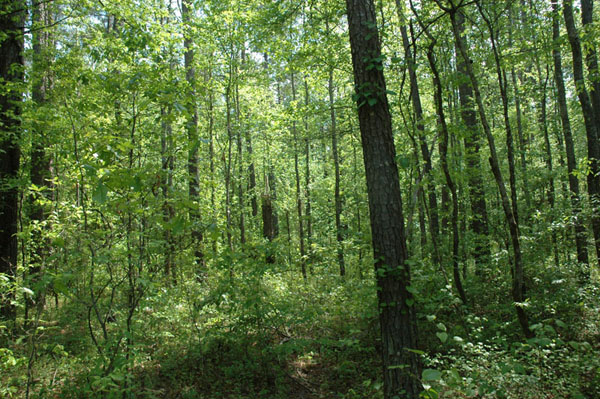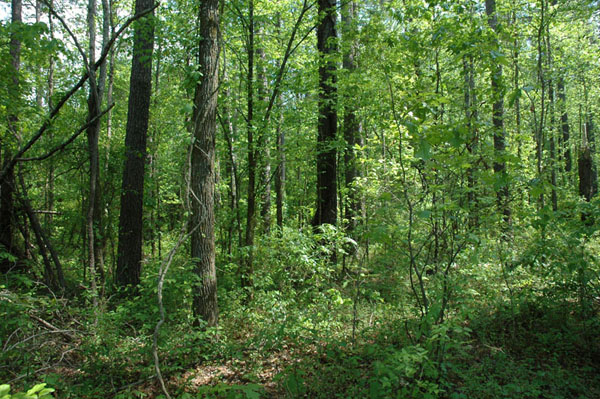Ants in Mixed Pine/Hardwood Forests of Noxubee National Wildlife Refuge, Mississippi
Joe A. MacGown and JoVonn G. Hill
Click links to view ants in the primary habitat types at the Noxubee National Wildlife Refuge.
[Noxubee Ants-all habitats] [pine forests] [pine/hardwood forests] [bottomland hardwood forests] [upland hardwood forests] [fields, grasslands, & other open areas] [disturbed wooded areas]
A recent project was undertaken by the MEM to survey the Noxubee National Wildlife Refuge in Oktibbeha, Noxubee, and Winston Counties for ants. The refuge owns approximately 48,000 acres, which can be separated into three primary habitats: forests, fields and grasslands, and wetlands. By far, forests form the majority of the refuge and cover about 45,000 acres (about 93%). The forests can be further divided into four major types including pine (23,619 acres), mixed pine/hardwood (2,851 acres), bottomland hardwood (15,453 acres), and upland hardwood (3,263 acres). In this study we examined six terrestrial habitat types to determine species compositions for each habitat. Habitat types for this study included pine forests (both mature and young forests, and recently burned or unburned); bottomland hardwood forests (including cypress dominanted areas); upland hardwood forests; mixed pine/hardwood forests (including one area intermixed with cedar); open habitats including fields, grasslands, roadsides, and a sand pit; and disturbed, open mixed forests located near buildings and picnic areas. The latter disturbed sites were included because of their likelihood of being ideal habitats for various exotic species. In addition to the ants collected during this survey, the total list of species from the refuge includes earlier records of ants collected by the Mississippi Entomological Museum (MEM). Collecting methods included baiting, beating and sweeping vegetation, litter sampling, and visually searching for ants and their colonies. Our collections have revealed a diverse fauna, and we have collected 98 species (species list) at the refuge.
Pine/hardwood forests at the Noxubee NWR total about 2,851 acres and are dominated by loblolly pine with some hardwoods such as oaks, hickories, blackgum and sweetgum mixed in. In some ways, this habitat type is hard to distinguish from pine forests, which may have a small percentage of some hardwoods present, or upland hardwood forests, which may have a small percentage of pines present. Even though the pine/hardwood habitat represents only a small fraction of the refuge, it appears to relatively diverse in ant species. This is probably due to the complexity of the vegetative structure and the apparent reduced amount of prescribed burning. We found 59 species in pine/hardwood habitats at the refuge (species list below).
 |
 |
Pine/hardwood habitat, relatively young and with abundant understory |
Pine/hardwood habitat, relatively young and with abundant understory |
Ants from Pine/hardwood Forests of the Noxubee National Wildlife Refuge
(Species are arranged alphabetically by genus)
Aphaenogaster carolinensis Wheeler
Aphaenogaster fulva Roger
Aphaenogaster lamellidens Mayr
Aphaenogaster treatae Forel
Camponotus americanus Mayr (pest)
Camponotus castaneus (Latreille) (pest)
Camponotus chromaiodes Bolton (pest)
Camponotus decipiens Emery (pest)
Camponotus discolor (Buckley) (pest)
Camponotus nearcticus Emery
Camponotus pennsylvanicus (DeGeer) (pest)
Camponotus snellingi Bolton (pest)
Camponotus subbarbatus Emery (pest?)
Colobopsis mississippiensis (Smith)
Colobopsis obliqua (Smith)
Crematogaster ashmeadi Mayr (pest)
Crematogaster lineolata (Say) (pest)
Crematogaster minutissima (Mayr)
Cryptopone gilva(Roger)
Discothyrea testacea Roger
Forelius mccooki (McCook) [only found nesting in soil at edges of woods and open areas]
Formica dolosa Buren
Formica pallidefulva Latreille
Hypoponera opacior (Forel)
Lasius aphidicola (Walsh)
Lasius americanus Emery
Monomorium minimum (Buckley) (pest)
Myrmecina americana Emery
Myrmica punctiventris Roger
Nylanderia faisonensis (Forel)
Nylanderia vividula (Nylander) (introduced?, pest)
Pheidole dentata Mayr (pest?)
Pheidole dentigula Smith
Pheidole tysoni Forel
Prenolepis imparis (Say)
Ponera exotica Smith
Ponera pennsylvanica Buckley
Proceratium croceum (Roger)
Pseudomyrmex ejectus (Smith) (pest?)
Solenopsis abdita Thompson
Solenopsis carolinensis Forel ?? [appears to be this species]
Solenopsis invicta x richteri (introduced, pest)
Solenopsis picta Emery
Stenamma impar Forel
Strumigenys angulata Smith
Strumigenys clypeata Roger
Strumigenys creightoni Smith
Strumigenys louisianae Roger
Strumigenys metazytes (Bolton)
Strumigenys missouriensis Smith
Strumigenys ohioensis Kennedy & Schramm
Strumigenys ornata Mayr
Strumigenys pulchella Emery
Strumigenys reflexa Wesson & Wesson
Strumigenys rostrata Emery
Strumigenys silvestrii Emery (introduced)
Strumigenys talpa Weber
Temnothorax curvispinosus (Mayr)
Temnothorax pergandei (Emery)
Links
MacGown, J. A., J. G. Hill, T. L. Schiefer, and R. L. Brown. 2012. Ant diversity and habitat associations at the Noxubee National Wildlife Refuge in Mississippi. Mississippi Agricultural and Forestry Experiment Station Technical Bulletin 1197. [pdf]
Landmarks article about the Noxubee Study [pdf]
Noxubee National Wildlife Refuge [http://www.fws.gov/noxubee/]


